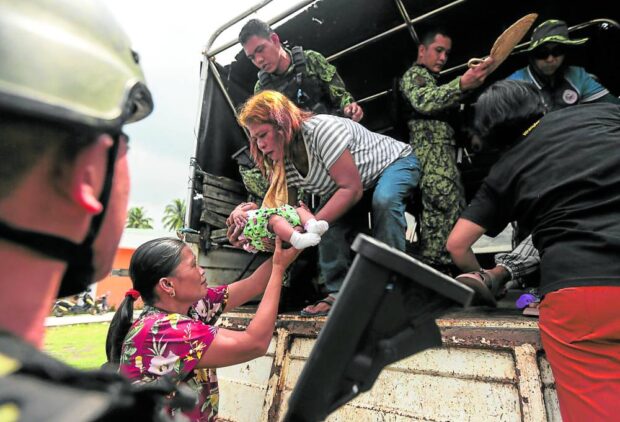‘Veteran’ Mayon evacuees grin and bear it

PREEMPTIVE MOVE The Albay provincial government expects to move about 4,000 families out of the 6-kilometer danger zone around the restive Mayon Volcano, including these residents in Guinobatan town on Friday. —MARK ALVIC ESPLANA
LEGAZPI CITY — As they prepared to evacuate on Friday, Josephine Buaze and her family members not only packed personal belongings but also gathered light building materials—bamboo poles, tarpaulin sheets, scraps of old plywood—good enough to make a small hut.
They were heading to the local elementary school where, during the last eruption of Mayon Volcano in January 2018, evacuees became a pitiful lot as they packed the classrooms. The Buazes would rather build their own shack on the campus grounds; it should be cooler there, with some measure of privacy, and the conditions perhaps relatively less miserable.
This is how “veteran” Mayon evacuees have learned to cope, and once again they are left with no choice as the provincial government hopes to move some 4,000 families away from the reawakened volcano.
“We cannot be accommodated in one classroom with 30 other families, and we cannot take the extreme heat,” said Buaze, 43, of Barangay Calbayog in Malilipot town, Albay province, one of the areas that officials want cleared of people and animals.
‘It’s escalating’
When the Inquirer spoke to her on Friday, Buaze was preparing to leave home together with her two siblings and their two children.
Article continues after this advertisementAnother Calbayog resident, Salvacion Bigcas, 37, brought food provisions that she, her husband, and their two children hoped would tide them over for two days. After that, she said, they would be relying entirely on relief goods.
Article continues after this advertisementWhen the Bigcas family fled the village during the 2018 eruption, they ended up staying at the evacuation center for almost three months.
The order to evacuate was issued on Thursday but the full scale—and hardship—of the exodus was only starting to reveal itself on Friday in Calbayog, one of the villages within the radius of Mayon’s 6-kilometer permanent danger zone.
The Philippine Institute of Volcanology and Seismology (Phivolcs) has raised the alert status in these areas to level 3, citing signs of a “hazardous eruption’’ happening within weeks or even days.
The agency reported a crater glow and “incandescent rockfall from new fluidal lava” at the Mayon summit at 9:27 p.m. on Thursday.
Paul Karson Alanis, a resident volcanologist at Phivolcs Legazpi, said the volcano initially had an “effusive eruption” that lasted for three to six minutes, with 199 “rockfall events.”
“It’s escalating probably because of the pressure. The magma has bubbles of gas inside, and while it is moving up the pressure pushing the lava becomes faster and stronger,” he explained in a phone interview on Friday.
The Albay provincial government said about 4,749 families, or 18,184 people in 14 villages within the danger zone, need to seek safer ground. It declared a state of calamity on Friday to authorize the use of some P30 million in calamity funds.
Some 10,000 animals—pets and livestock—must also be moved out of the affected villages.

AWAY FROM DANGER ZONE Evacuees are hauled off to shelters from a village in Giunobatan town, Albay, on Friday, a day after Phivolcs raised the Mayon Volcano alert status to level 3. —MARK ALVIC ESPLANA
Tents needed
In Camalig town, evacuations also started at barangays Tumpa, Quirangay, and Cabangan, with some villagers given modular tents at Barangay Bongabong.
In Albay’s Guinobatan town, a tent shortage was already becoming a concern.
“The situation today is different. The whole village had been evacuated,” said Marites Alcala, chair of Barangay Tandaroro.
Guinobatan Mayor Paul Chino Garcia also confirmed the problem, but said he had already informed the Department of Social Welfare and Development (DSWD) about it and “they will provide at least 500 tents for our evacuees.”
Also on Friday, Phivolcs officer in charge, Director Teresito Bacolcol, said the permanent danger zone around Mayon might be extended to 8 km should the alert status be raised to level 4.
“There is always that possibility’’ like what happened in 2018, Bacolcol said at the Laging Handa briefing.
Albay’s two congressmen—Representatives Joey Salceda and Edcel Lagman—assured affected residents of immediate aid coming from the DSWD.
Salceda said Social Welfare Secretary Rex Gatchalian had responded to his request for food packs for the evacuees that can last for at least 45 days and up to 90 days.
“The scenarios are based on historical experience with Mayon’s volcanic activity, where evacuation tends to be protracted to 47 days or 90 days,” Salceda said, quoting his formal request to the DSWD.
He said he had asked for 147,435 food packs for the 45-day scenario, and 294,870 food packs for the 90-day scenario, or “at least 50 percent of the 45-day requirement.”